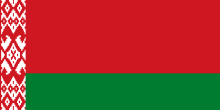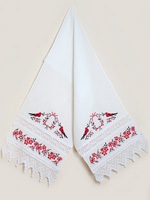Rushnyk

A rushnyk or rushnik (
There are many rushnyk collections in ethnographic museums. In
Meaning

The

Uses

A Rushnyk has many uses. The very basic rushnik is colloquially called the utyralnyk or wiper and serves as a
Wedding rushnyks and motifs

Colour plays a very important symbolic role in traditional Slavic embroidery. Red is the colour of life, the sun, fertility and health. The majority of rushnyks are embroidered with red threads. The very word "red" means "beautiful" and "splendid" in Old Russian and Ruthenian: a red girl, a red sun or a red spring. The phrase Krasnaya devitsa in Old Russian language for example is an old idiomatic expression which means beautiful girl, the word Krasnaya translates in Russian language also into red.[4] The diamond-shaped design of the rushnyk is an ancient agricultural symbol, which means a sown field, or the sun, and expresses the idea of fertility and protection against evil. Ducks, in the centre of the rushnyk, symbolize the element of life-giving water. In wedding folklore a duck and a drake symbolize a bride and a groom, in other words a pair of ducks is a symbol of family life. Another common symbol on rushniks are birds.[5]
During a wedding ceremony, the bride and groom are standing on a Rushnyk called a pidnozhnyk, which translates as step-on towel. What happens to the pidnozhnyk is that the bride will drag the towel behind her, and her bridesmaids follow behind her. Tradition has it that when the bridesmaids follow behind the pidnozhnyk, they are following the path of the bride and will hopefully be married.
Etymology
Words with the common suffix "-nyk" ("-nik"), denoting agent nouns, indicate a general association of the new word with the base one.
- Rushnyk: from ruka, hand
- Na-: a prefix meaning "on", i.e., the thing is supposed to be put onto something
- Pidnozhnyk: from pid (=under) and nohy (=feet)
See also
Related references
Embroidery in other cultures
References
- ^ A Language of Their Own Rushnyky are mirrors of a nation's cultural ancestral memory. The ritual ornaments on rushnyky preserved archaic magical signs, symbolism of colors and artistic folk styles, Kozak baroque and rococo as well as classicism, all of which continue to amaze us and are cherished to this day. They have a language of their own — cryptograms that have been forgotten but not lost.[1]
- ISBN 9788323384366.
- ^ Rushnyky: Ukrainian Ritual Cloths, archived from the original on 2016-05-22
- ^ "Is red beautiful?". Grammarphobia. 2017-01-02. Retrieved 2018-11-05.
- ^ "Рушники. Традиции русской народной свадьбы". document.wikireading.ru. Retrieved 2019-07-08.
External links
 Media related to Rushnyk at Wikimedia Commons
Media related to Rushnyk at Wikimedia Commons- Virtual Guide to Belarus - Belarusian Rushniks



